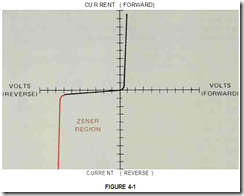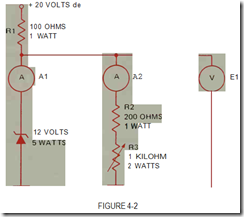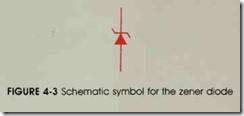Objectives
After studying this unit, the student will be able to:
• Explain the difference between a junction diode and a zener diode
• Discuss common applications of the zener diode
• Connect a zener diode in a circuit
The zener diode is a special device designed to be operated with reverse polarity applied to it. When a diode is broken down in the reverse direc tion, it enters what is known as the zener region. Usually, when a diode is broken down into the zener region, it is destroyed; the zenet diode, however, is designed to be operated in this region without harming the device.
When the reverse breakdown voltage of a ze ner diode is reached, the voltage drop of the de vice remains almost constant regardless of the amount of current flowing in the reverse direction, figure 4-1. Since the voltage drop of the zener diode is constant, any device connected parallel to the zener will have a constant voltage drop even if the current through the load is changing.
In figure 4-2, resistor R1 is used to limit the total current of the circuit. Resistor R2 is used to limit the current in the load circuit. Note that the value of R1 is less than the value of R2. This is to insure that the supply can furnish enough current to operate the load. Note also that the supply volt age is greater than the zener voltage. The supply voltage must be greater than the voltage of the ze ner diode or the circuit cannot operate.
Resistor R1 and the zener diode form a series circuit to ground. Since the zener diode has a volt age drop of 12 volts, resistor R1 has a voltage drop of 8 volts: (20 volts – 12 volts = 8 volts). There fore, resistor R1 will permit a maximum current flow in the circuit of .08 amperes or 80 milliamps 
The load circuit, which is a combination of R2 and R3, is connected parallel to the zener diode. Therefore, the voltage applied to the load circuit must be the same as the voltage dropped by the zener. If the zener diode maintains a con stant 12-volt drop, a constant voltage of 12 volts must be applied to the load circuit.
The maximum current that can flow through
the load circuit is .06 amperes or 60 rnA 
Notice that the value of R2 (200 ohms) is used to insure that there is enough current available to op erate the load.
The maximum current allowed into the cir
cuit by resistor R1 is always equal to the sum of the currents passing through the zener diode and the load. For example, when the load is connected parallel to the zener diode as shown in figure 4-2, and resistor R3 is adjusted to 0 ohms, meter A 1 will indicate a current of 20 rnA, and meter A2 will indicate a current of 60 rnA. Therefore, the maximum current allowed into the circuit by resis
tor R1 will be 80 rnA (20 rnA + 60 rnA = 80
rnA). The voltage value indicated by meter E1 will
be the same as the zener voltage value.
If resistor R3 is increased in value to 200 ohms, the resistance of the load will increase to 400 ohms (200 + 200 = 400). Meter A 1 will in
dicate a current of SO rnA and meter A2 will indi cate a current of 30 rnA. The voltage value indi cated by meter E 1 will still be the same as the zener voltage value.
The zener diode, therefore, mak es a VeT)‘ effec
tive voltage regulator for the load circuit. Although the current through the load circuit changes , the zener diode forces the voltage across the load cir cuit to remain at a constant value, and conducts the current not used by the load circuit to ground.
The schematic symbol for a zener diode is shown in figure 4-3. The zener diode can be tested with an ohmmeter in the same manner as a com mon junction diode is tested, provided the zener voltage is greater than the battery voltage of the ohmmeter.
REVIEW QUESTIONS
1. How is a zener diode connected in a circuit as compared to a common junction diode?
2. What is the primary use of a zener diode?
3. A 5.1-volt zener diode is to be connected to an 8-volt power source. The current must be limited to 50 rnA. What value of current-limiting resistor must be connected in series with the zener diode?
4. How is a zener diode tested?
In a zener diode circuit, the current-limiting resistor limits the total circuit current to ISO rnA. If the load circuit is drawing a current of 90 rnA, how much current is flowing through the zener diode?


